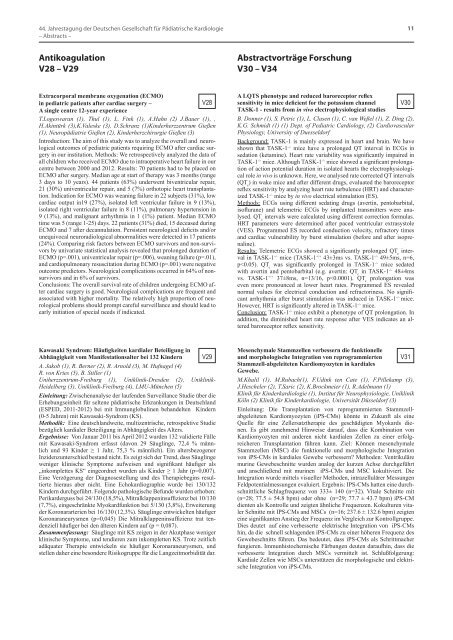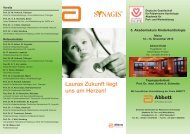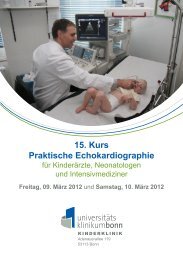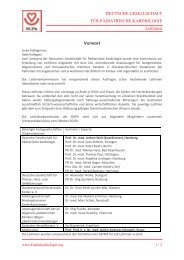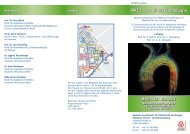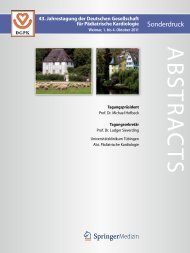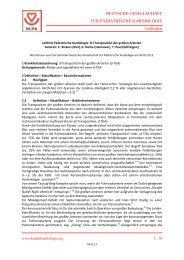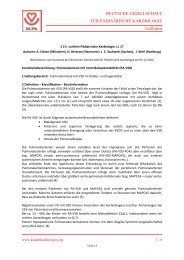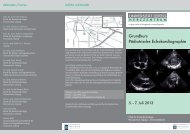Abstraktband als pdf - DGPK-Deutsche Gesellschaft für Pädiatrische ...
Abstraktband als pdf - DGPK-Deutsche Gesellschaft für Pädiatrische ...
Abstraktband als pdf - DGPK-Deutsche Gesellschaft für Pädiatrische ...
Sie wollen auch ein ePaper? Erhöhen Sie die Reichweite Ihrer Titel.
YUMPU macht aus Druck-PDFs automatisch weboptimierte ePaper, die Google liebt.
44. Jahrestagung der <strong>Deutsche</strong>n <strong>Gesellschaft</strong> für Pädiatrische Kardiologie<br />
– Abstracts –<br />
11<br />
Antikoagulation<br />
V28 – V29<br />
Abstractvorträge Forschung<br />
V30 – V34<br />
Extracorporal membrane oxygenation (ECMO)<br />
in pediatric patients after cardiac surgery –<br />
V28<br />
A single centre 12-year experience<br />
T.Logeswaran (1), Thul (1), L. Fink (1), A.Hahn (2) J.Bauer (1), ,<br />
H.Akintürk (3),K.Valeske (3), D.Schranz (1)Kinderherzzentrum Gießen<br />
(1), Neuropädiatrie Gießen (2), Kinderherzchirurgie Gießen (3)<br />
Introduction: The aim of this study was to analyze the overall and neurological<br />
outcomes of pediatric patients requiring ECMO after cardiac surgery<br />
in our institution. Methods: We retrospectively analyzed the data of<br />
all children who received ECMO due to intraoperative heart failure in our<br />
centre between 2000 and 2012. Results: 70 patients had to be placed on<br />
ECMO after surgery. Median age at start of therapy was 3 months (range<br />
3 days to 10 years). 44 patients (63%) underwent biventricular repair,<br />
21 (30%) univentricular repair, and 5 (7%) orthotopic heart transplantation.<br />
Indication for ECMO was weaning failure in 22 subjects (31%), low<br />
cardiac output in19 (27%), isolated left ventricular failure in 9 (13%),<br />
isolated right ventricular failure in 8 (11%), pulmonary hypertension in<br />
9 (13%), and malignant arrhythmia in 1 (1%) patient. Median ECMO<br />
time was 5 (range 1-25) days. 22 patients (31%) died, 15 deceased during<br />
ECMO and 7 after decannulation. Persistent neurological deficits and/or<br />
unequivocal neuroradiological abnormalities were detected in 17 patients<br />
(24%). Comparing risk factors between ECMO survivors and non-survivors<br />
by univariate statistical analysis revealed that prolonged duration of<br />
ECMO (p=.001), univentricular repair (p=.006), weaning failure (p=.01),<br />
and cardiopulmonary resuscitation during ECMO (p=.001) were negative<br />
outcome predictors. Neurological complications occurred in 64% of nonsurvivors<br />
and in 6% of survivors.<br />
Conclusions: The overall survival rate of children undergoing ECMO after<br />
cardiac surgery is good. Neurological complications are frequent and<br />
associated with higher mortality. The relatively high proportion of neurological<br />
problems should prompt careful surveillance and should lead to<br />
early initiation of special needs if indicated.<br />
A LQTS phenotype and reduced baroreceptor reflex<br />
sensitivity in mice deficient for the potassium channel V30<br />
TASK-1 - results from in vivo electrophysiological studies<br />
B. Donner (1), S. Petric (1), L. Clasen (1), C. van Weßel (1), Z. Ding (2),<br />
K.G. Schmidt (1) (1) Dept. of Pediatric Cardiology, (2) Cardiovascular<br />
Physiology, University of Duesseldorf<br />
Background: TASK-1 is mainly expressed in heart and brain. We have<br />
shown that TASK-1 -/- mice have a prolonged QT interval in ECGs in<br />
sedation (ketamine). Heart rate variability was significantly impaired in<br />
TASK-1 -/- mice. Although TASK-1 -/- mice showed a significant prolongation<br />
of action potential duration in isolated hearts the electrophysiological<br />
role in vivo is unknown. Here, we analysed rate corrected QT interv<strong>als</strong><br />
(QT c<br />
) in wake mice and after different drugs, evaluated the baroreceptor<br />
reflex sensitivity by analyzing heart rate turbulence (HRT) and characterized<br />
TASK-1 -/- mice by in vivo electrical stimulation (ES).<br />
Methods: ECGs using different sedating drugs (avertin, pentobarbital,<br />
isoflurane) and telemetric ECGs by implanted transmitters were analysed.<br />
QT c<br />
interv<strong>als</strong> were calculated using different correction formulas.<br />
HRT parameters were determined after paced ventricular extrasystole<br />
(VES). Programmed ES recorded conduction velocity, refractory times<br />
and cardiac vulnerability by burst stimulation (before and after isoprenaline).<br />
Results: Telemetric ECGs showed a significantly prolonged QT c<br />
interval<br />
in TASK-1 -/- mice (TASK-1 +/+ 43±3ms vs. TASK-1 -/- 49±5ms, n=6,<br />
p


